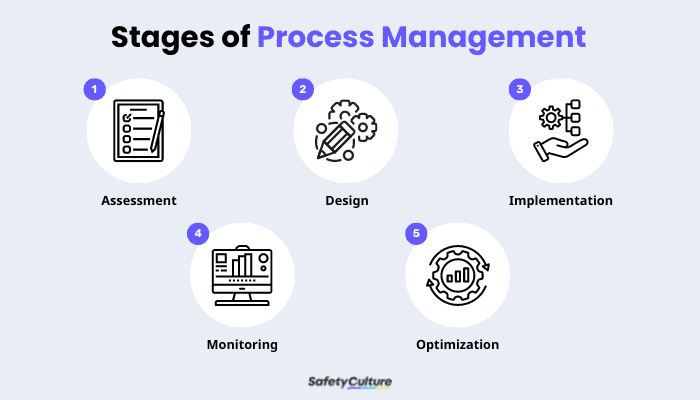What is Process Management?
Process management is the practice of managing and optimizing the processes that are used to complete tasks and achieve goals. Also known as business process management (BPM), it involves understanding current systems and practices, identifying areas for improvement, and carrying out changes to increase efficiency and effectiveness.
Importance
Process management can bring a number of benefits to organizations. Most importantly it can support the organization by improving its efficiency. Streamlining processes can reduce the amount of time and resources needed to complete tasks. This, in turn, leads to increased productivity and cost savings.
This approach allows them to clearly understand how their processes work. They can identify areas for improvement such as blockers and bottlenecks. Processes can then be adapted to ensure that tasks are done accurately and efficiently. The result empowers them to maximize their resources through efficient planning and management.
Furthermore, BPM allows organizations to become more agile and responsive to customer needs. By fully understanding the ins and outs of their systems and processes, they can quickly adjust their approach to the ever-changing market conditions and improve the quality of their product or service to meet customer demands.
Types
Before planning a BPM strategy, it’s important to understand first its different types. The approach selected will depend on the kind of process you need to deal with. Here are the three types of process management that organizations often encounter:
- System-centric – This type focuses on workflows at the core of business operations. The processes that fall under this category usually involve automation and technological tools—basically, those that function on their own without the help of humans. The ISO management system, for instance, falls under this category.
- Human-centric – As opposed to the former type, this category of process management revolves around processes that require human expertise or interaction to implement. An example of this is a sorting operative for waste management.
- Document-centric – The final type of process management is concerned with handling company records and documents. Processes that require administrative assistance usually belong in this category. One example of this is the procedure for preparing, keeping, and verifying contracts with suppliers.
BPM Methods
Process management encompasses a variety of different approaches with their own unique set of advantages and disadvantages. Some of the most common BPM methods include:
Lean
Lean process management is a method that focuses on eliminating waste and enhancing efficiency. It revolves around the idea that any process can be improved by reducing the amount of time, effort, and resources required to complete it. This approach is often used in manufacturing and production settings.
Six Sigma
Six Sigma is a process management system that centers on lessening defects and improving quality. By decreasing the number of defects and increasing the accuracy of the process, it can significantly improve business processes. Customer service and product development teams can benefit from this method.
Agile
Agile process management focuses on flexibility and adaptability. It handles and improves processes by allowing for rapid changes and adjustments. For this reason, it works best in software development and IT environments.
Stages of Process Management
Process management undergoes five stages: assessment, design, implementation, monitoring, and optimization. In this section, discover how each step works and how they fit in the process management framework.

1. Assessment
Process management begins with an initial assessment of the organization’s current processes. It involves mapping out the details of existing procedures, determining which ones need to be improved based on select performance metrics, and analyzing which to prioritize among the least efficient options.
When sketching out current processes, consider including the following questions:
- How does the process work?
- Who is in charge of this process?
- How long does it take to complete this process?
- How often is this process done?
2. Design
After evaluating, the next step is to develop a strategy to enhance a specific process. At this stage, teams will plan how the new process will ideally work from start to finish, along with additional information to supplement it. One good example is creating a flowchart to visualize things in a step-by-step fashion.
As an additional step, they can simulate how the new process will turn out in different scenarios before carrying it out in practice.
3. Implementation
Once the process design is complete, it’s time to put things into practice. Initiatives can come in the form of automating manual tasks or standardizing work processes. Some will require technological updates to execute, while others will call for modifications in procedures, resource allocation, or training.
4. Monitoring
The process doesn’t end with implementing things on the ground. Since process management requires long-term commitment, consistent monitoring is vital to its success. At this stage, teams will track how their newly implemented process performs over a specific period. Gathering this information will help them determine which things work and which parts require change.
Digitize the way you Work
Empower your team with SafetyCulture to perform checks, train staff, report issues, and automate tasks with our digital platform.
Get Started for Free5. Optimization
Continuous improvement is key for long-term process management strategies. Over a specific time frame, teams can further refine their newly established process using the data collected during the monitoring stage. This enables them to make informed decisions about changing certain parts of the process to improve its performance, keep up with the fast-paced changes in their industry, and satisfy customer needs.
Challenges in Managing Processes
Process management is by no means an easy task, and challenges can arise when attempting to implement it. Here are the most common areas where roadblocks can occur in managing business processes:
- Getting stakeholders on board – Buy-in from stakeholders—from customers and suppliers to employees and management, among others—is a vital element in successful process management but can be difficult to achieve. After all, different stakeholders may have varying opinions on how the process should be managed.
- Setting unclear objectives and goals – These elements establish the purpose and direction in which things are headed. Thus, a process is bound to fail if the BPM strategy doesn’t clearly define the short- and long-term outcomes that it aims to achieve.
- Communicating across teams – Successfully managing processes requires open communication among the members involved. Lacking this crucial factor can result in conflict and errors in carrying things out, which can cost the team productivity and efficiency.
- Consistently following through processes – As the process evolves, it can be difficult to ensure that all stakeholders are aware of the changes and that the process is still efficient and effective. However, ensuring that the process is consistently followed and documenting changes can be tedious, especially in fast-paced environments.
- Tracking performance metrics – Process management doesn’t stop once the process has been carried out; it has to be monitored continuously to ensure its success. This task becomes daunting when there are multiple processes to check and no established benchmarks to measure success or failure.
Best Practices in Process Management
Given the challenges mentioned above, how can leaders effectively manage their existing and prospective processes? Here are the best practices for effectively developing and managing business processes:
- Include key stakeholders in process management – Involving customers, suppliers, and partners in the process help ensure that everyone is on the same page and that the process is being implemented correctly.
- Anchor process goals on organizational operations – Establishing goals in this way allows teams to clearly define how the process aligns with the company’s business goals, which helps in setting their BPM strategy up on the right path.
- Document all processes – Transparency is key to effective communication. For this reason, thoroughly documenting every step of the process, including all changes made, will help ensure that everyone in the organization is aware of the steps involved in each task and that they are being followed accurately.
- Measure process performance – Track key performance indicators (KPIs) such as completion time, cost, and customer satisfaction. Doing so helps pinpoint areas that require further work and ensure that things are running as efficiently as possible.
- Regularly review and update processes – Holding periodic reviews of processes is key to ensuring that they are still relevant and effective for the current time and context.
FAQs about Process Management
These concepts are related to one another but with distinct differences. Process management encompasses the entire lifecycle of a business process, from conceptualization to continuous improvement. Meanwhile, just as the name implies, process improvement focuses on methods to enhance existing systems, making it a vital component of process management.
Process management is a valuable tool for any organization that wants to streamline its operations and enhance efficiency. It can be used by any size of business, from small startups to large corporations. It also applies to any industry, from manufacturing to healthcare to hospitality.
The five most common risks associated with process management are as follows:
- Potential for errors – If processes are not properly documented, mistakes can be made that can lead to costly delays or even complete failure of the process.
- Timeliness of process reviews – If they are not regularly updated to reflect changes in the business environment, they can become outdated and ineffective.
- Inconsistencies in monitoring – It can be difficult to detect and respond to security threats promptly without properly monitoring process initiatives.
- Security breaches – If processes are not properly secured, they can be vulnerable to malicious actors who can gain access to sensitive information or disrupt the process.
- Complexity in design – Overly complex process designs will require too much time and resources to complete, thus making them counterproductive.
Process management tools can range from simple software programs to more complex enterprise-level solutions. Some of the most popular ones include workflow automation software, project management software, and BPM software.



